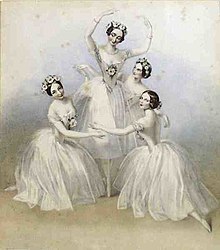
Marie Taglioni
Marie Taglioni, Comtesse de Voisins (23 April 1804 – 22 April 1884) was a Swedish ballet dancer of the Romantic ballet era, a central figure in the history of European dance. She was one of the most celebrated ballerinas of the romantic ballet, which was cultivated primarily at Her Majesty’s Theatre in London, and at the Théâtre de l’Académie Royale de Musique of the Paris Opera Ballet.
She is credited with (though not confirmed) being the first ballerina to truly dance en pointe.
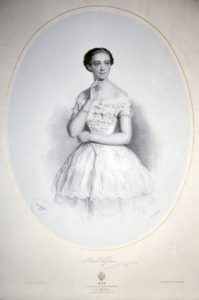
Taglioni was born in Stockholm, Sweden,
to Italian choreographer Filippo Taglioni and Swedish ballet dancer Sophie Karsten.
Taglioni moved to Vienna with her family at a very young age where she began her ballet training under the direction of Jean-Francois Coulon and her father. After Filippo was appointed the ballet master at the court opera in Vienna there was a decision that Marie would debut in the Habsburg capital.
Even though Marie had trained with Coulon,
her technique was not up to the standards that would impress the Viennese audiences.
Her father then created a rigorous six-month training regimen for his daughter where she would hold positions for 100 counts. The training was conducted daily and consisted of two hours in the morning with difficult exercises focusing on her legs and two hours in the afternoon focusing on adagio movements that would help her refine poses in ballet.
Taglioni had a rounded back that caused her to lean forward and had slightly distorted proportions. She worked hard to disguise her physical limitations by increasing range of motion and developing her strength. Taglioni focused her energy on her shape and form to the audience and less on bravura tricks and pirouettes. In Vienna, Marie danced her first ballet choreographed by her father titled “La Reception d’une Jeune Nymphe à la Cour de Terpsichore”.
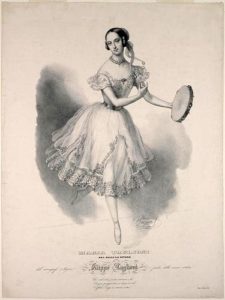
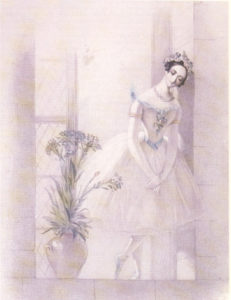
Before joining the Paris Opéra, Taglioni danced in both Munich and Stuttgart, and at age 23 debuted in another ballet choreographed by her father called “La Sicilien” that jump-started her ballet career.
Taglioni rose to fame as a danseuse at the Paris Opéra when her father created the ballet La Sylphide (1832) for her.
Designed as a showcase for Taglioni’s talent, it was the first ballet where dancing en pointe had an aesthetic rationale and was not merely an acrobatic stunt, often involving ungraceful arm movements and exertions, as had been the approach of dancers in the late 1820s.
In 1837 Taglioni left the Ballet of Her Majesty’s Theatre to take up a three-year contract in Saint Petersburg with the Imperial Ballet (known today as the Kirov/Mariinsky Ballet). It was in Russia after her last performance in the country (1842) and at the height of the “cult of the ballerina”, that
a pair of her pointe shoes were sold for two hundred rubles, reportedly to be cooked, served with a sauce and eaten by a group of balletomanes.
In July 1845, she danced with Lucile Grahn, Carlotta Grisi, and Fanny Cerrito in Jules Perrot’s Pas de Quatre, a ballet representing Taglioni’s ethereal qualities that was based on Alfred Edward Chalon’s lithographic prints. Pas de Quatre was originally choreographed to be presented to Queen Victoria, who attended the third performance.
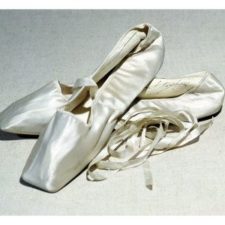

Taglioni retired from performing in 1847; for a time, she took up residence at the Ca’ d’Oro on the Grand Canal in Venice. When the ballet of the Paris Opéra was reorganized on stricter, more professional lines, she was its guiding spirit. With the director of the new Conservatoire de danse, Lucien Petipa, and Petipa’s former pupil, the choreographer Louis Mérante, she figured on the six-member select jury of the first annual competition for the corps de ballet, held 13 April 1860.
Her only choreographic work was Le papillon (1860) for her student Emma Livry, who is remembered for dying in 1863 when her costume was set alight by a gas lamp used for stage lighting. Johann Strauss II composed the “Marie Taglioni Polka” (Op. 173) in honour of Marie Taglioni’s niece, Marie “Paul” Taglioni, also known as “Marie the Younger”. The two women, having the same name, have often been conflated, or confused with each other.
Later in England, she taught social dance and ballroom to children and society ladies in London; she also took a limited number of ballet pupils. She resided at 14 Connaught Square, London from 1875 to 1876.
Taglioni died in Marseille on 22 April 1884, the day before her 80th birthday. Her body was moved to Paris. There is some debate over whether she is buried in Montmartre or in Père Lachaise, or if the grave Montmartre site belongs to her mother.
The local dancers began leaving their worn pointe shoes on the Montmartre grave as a tribute and thanks to the first pointe dancer.
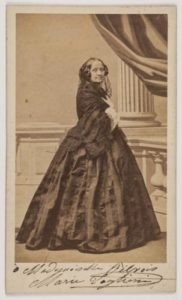
Source: Wikkipedia
